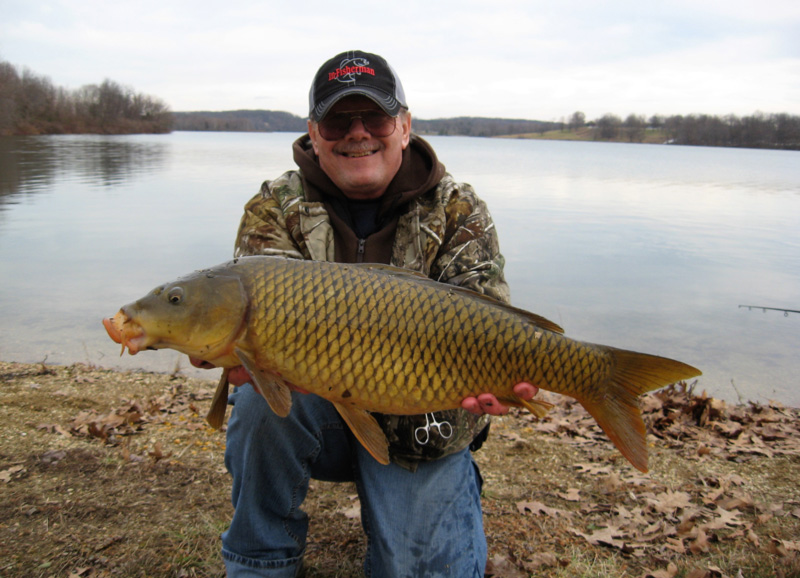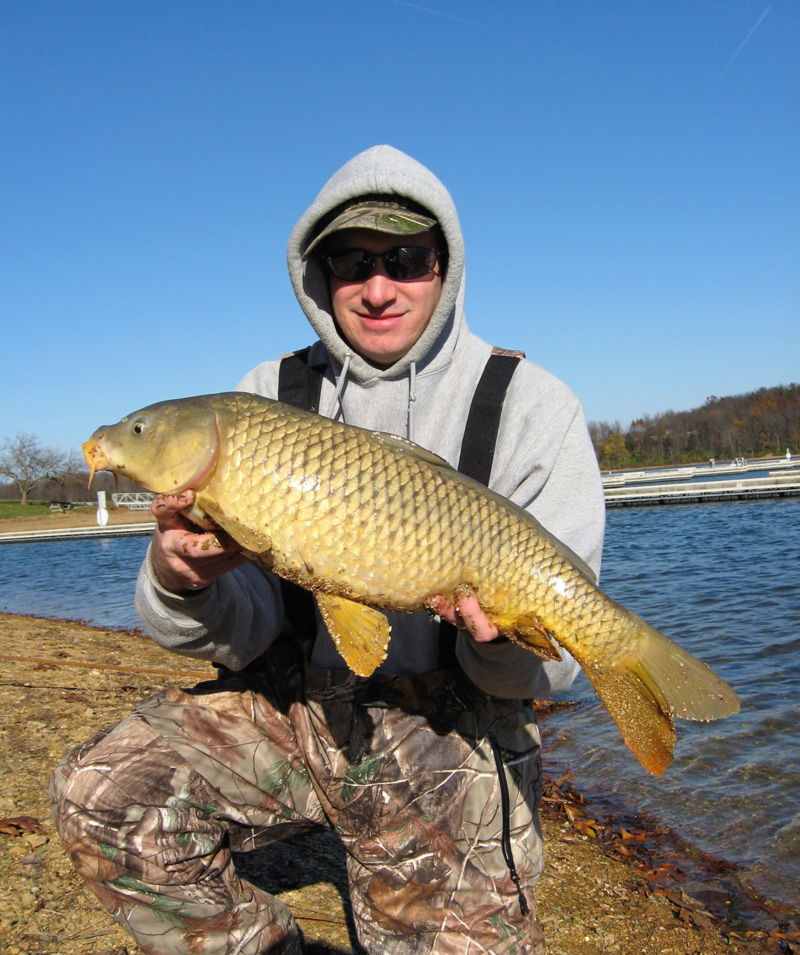About 10 years ago I got hooked up with a bunch of low-life, bottom scroungers that had all the skills it took to bend a rod throughout the winter. No, these guys weren’t drug dealers or even politicians. Rather, they were serious, hard-core anglers who just liked the feel of a big, bottom-scrounging fish on the end of their rods all winter long. They taught me a lot and by the end of each mild winter I had several dozen 10 to 20 pound plus carp on my punch card. Maybe not earth shattering to offshore anglers seeking bigger saltwater gamesters, but to most freshwater enthusiasts a 10-pound-plus fish is pretty big any day of the week

Not long after I got the basics down, I set out on my own to learn more and struggle at times. The company I kept was great while it lasted, and I indeed made new friends with some great guys. But other angling friends of mine just couldn’t “get it” as to what made winter carp fishing so special. So, here’s the scoop.
Winter Carp Fishing Tactics
To begin with, carp are creatures of habit and where permitted they can be conditioned to feed on a variety of baits and chumming methods. This applies to all water temperature ranges. Some of my biggest carp have been caught from January to March. However, in many places these fish just routinely cruise and bottom feed where water temperatures are warmer or flows are slower, such as many tidal rivers throughout the Chesapeake region. Anglers who employ European carp tactics will chum or bait specific areas to draw carp in. Simple mixes of corn, oats, pineapple chunks, bean varieties, and even bird seeds can coax these heavyweights in the winter. Many local carp experts have their own special mixes that they toss with a baiting shovel or even just throw to an area to attract fish. Others simply fish areas known to hold carp throughout the year. Baiting an area is good, but not always necessary.
For the sake of comfort, mild, warmer days are easy on the body and frequently yield the highest carp activity in the winter. Late afternoon sunlight can draw fish shallow, as can calm tidal eddies with minimal current that have a variety of food items funneled to the spots.
Although we employ seven- and eight-foot carp rods from European companies, it’s not necessary to do so. Any medium heavy spinning rods (Ugly Sticks are great) that team well with 15 to 20-pound mono or braid will work in most situations. Bait-runner style reels are preferred as we like to let the fish run before setting the hooks in the tough, rubbery mouths of these overgrown goldfish. In-line weights from a half ounce to two ounces will work in most situations and when rigged in a Carolina style (line can run through the weight sitting on the bottom) it’s easy to lift the rod out of a holder and tighten the drag, setting the hook.
Carp are sensitive, spooky feeders all year long and during the winter even more so. We have used bite alarms teamed on rod pods or bank sticks, items that keep line direction low and aimed at the feeding carp. Simple forked sticks can work with an open bail so that the fish do not feel any weight during the initial bite. Once they take off, simply close the bail and set the hook.

Carp Fishing Hooks
Many hook styles work for carp and we like those used by the Euro-crowd made specifically for heavyweight carp, which are of a heavier gauge than most American-made bait hooks. Ideally, a #2 or #4 bait-holder style hook does well when covered with any dough, corn, or pack bait that can stay on the hook for 30-minutes or longer. (Winter carpers don’t usually have the aggravation of sunfish and crayfish stripping baits during the cold-water periods). We have had good success with the time-honored Eagle Claw baitholder hooks in sizes #1 and #2 when tied directly to our main line with a slip sinker or “no roll” sinker placed above it and secured with a split-shot to prevent the sinker from running down the line and impeding the bait.
Often, we will utilize a hair rig where a small length of line (traditionally 20-pound braid) is extending past the bend of the hook and used to anchor several kernels of flavored corn or “boilies.” The line has a loop at the tag end and a small piece of plastic or string is inserted through the loop to secure the baits. The hook remains un-baited, and when the carp take the corn in their mouths the hook just follows. When the fish feel the prick of the hook point, they “spook” or “bolt,” thus setting off your bite alarm or peeling line from an open bail.
Carp Fishing Lines
The jury is still out among seasoned carpers as to which type of line is best for these fish. Many still favor quality monofilament in the 14- to 20-pound strengths and tie hooks and thread weights directly to the main line, minimizing knots or other terminal connections. Yet for those seeking long-distance fish from the shore that can exceed 75-yards, they are looking for a better hookset with the low-stretch braids. Often, a 20- to 30-pound braid is secured with a 15- to 20-pound class mono leader of clear, softer qualities. Sensitive feeders, carp may shun baits on stiffer fluorocarbon rigs. Here again, the choice is often personalized and many European tackle companies produce leader material specifically for these and other situations.
Yes, winter carp fishing can be a great endeavor during mild winter days when you’re just hankerin’ for a fight with a big fish. Check out Whacker Baits and Big Carp Tackle the next time you get on the web and you’ll be amazed at what is out there for the modern-day carp angler. Baits, flavorings, lines, weight, hooks, hair-rigs, and specialized gear for sure. But you don’t need all of that to get started in some big-fish action this winter. And as long as there is no ice you can catch a carp all winter long.
- By Jim Gronaw
Editor’s note: We’d like to remind everyone that carp are primarily a catch-and-release species. While we’d never deter anyone from trying a new type of fish for dinner, very few people find carp to their liking. We’d recommend handling the fish gently and releasing them while following best catch-and-release practices.